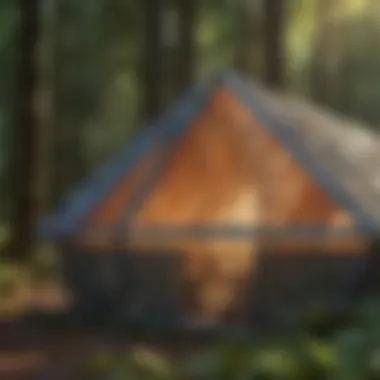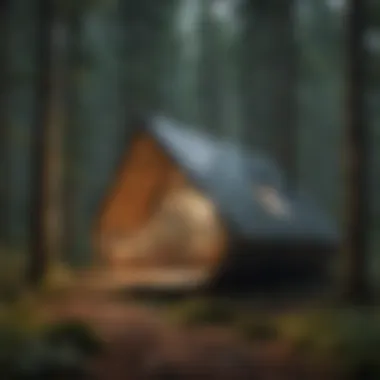Exploring Diamond Shelters for Woodland Conservation


Intro
Diamond shelters represent a progressive intersection between architectural design and ecological integrity. These structures are significant in providing essential habitat and protection for various species, all while maintaining a commitment to sustainability. Understanding their construction, benefits, and broader implications in woodland stewardship is critical for forestry professionals, conservationists, and academic researchers. Here, we explore the intricate dynamics of woodland ecosystems, sustainable forestry practices, and effective woodland stewardship techniques that frame the context for diamond shelters.
Understanding Woodland Ecosystems
Wooodland ecosystems play a crucial role in maintaining biodiversity. They host a multitude of species, from mammals to flora, each creating an interdependent network that enhances ecological stability. The vitality of these ecosystems is largely tied to their biodiversity. In forests, each species performs a unique role, whether in pollination, seed dispersal, or nutrient cycling. This diversity is a buffer against ecological disturbances, allowing ecosystems to adapt and recover more easily.
Importance of Biodiversity in Forests
Biodiversity in forests is not just about the number of species; it’s about the relationships between them. A rich variety of species can enhance resilience against pests and diseases. Furthermore, diverse genetic resources are essential for breeding programs aimed at improving species adaptability to changing climates. Protecting biodiversity is fundamental to sustaining the ecosystem services provided by forests, which include water filtration, carbon storage, and soil stabilization.
Role of Forests in Climate Regulation
Forests play a significant role in climate regulation. They act as carbon sinks, absorbing carbon dioxide from the atmosphere and helping to mitigate climate change. Moreover, forests contribute to local and global water cycles, influencing precipitation patterns and maintaining aquifers. By fostering healthier tree populations, we not only enhance forest carbon storage but also improve their ability to regulate climate.
Sustainable Forestry Practices
The principles of sustainable forestry focus on managing forest resources to meet current needs while ensuring ecological integrity for future generations. Key methods include selective logging, maintaining forest structure, and incorporating biodiversity metrics into management plans. This approach aims to minimize negative impacts on the ecosystem while fulfilling timber production and other forest resource needs.
Principles of Sustainable Forestry
- Ecosystem Management: Focuses on maintaining the health of ecosystems while balancing human needs.
- Conservation of Biodiversity: Ensures that various species thrive, contributing to forest resilience.
- Community Involvement: Engaging local communities in decision-making promotes stewardship and sustainable practices.
Case Studies of Successful Implementations
Several case studies illustrate successful implementations of sustainable forestry. For example, in the Pacific Northwest, the Adaptive Management Area program effectively combines ecological science with hands-on management. In Sweden, the Swedish Forestry Association promotes biodiversity by setting aside protected areas within commercial forests. These examples highlight the importance of integrating sustainable techniques in real-world forestry.
Woodland Stewardship Techniques
Woodland stewardship encompasses various methods aimed at promoting forest health and resilience. Effective management plans prioritize ecosystem restoration, invasive species control, and habitat enhancement. The goal is to create a sustainable balance between human usage of the forest and its preservation for future generations.
Forest Management Plans
Comprehensive forest management plans involve assessing forest conditions, setting objectives for resource use, and implementing strategies for long-term health. These plans should incorporate data on species diversity, soil conditions, and climate impacts, aiming for an adaptable approach as conditions change over time.
Conservation Strategies
Conservation strategies include habitat restoration, reforestation initiatives, and protection of old-growth forests. Establishing wildlife corridors and reducing fragmentation are crucial to facilitating species movement and ensuring ecological connectivity. Successful conservation also requires monitoring and evaluating the effectiveness of strategies to adapt and refine efforts.
Effective woodland stewardship requires ongoing commitment, innovative approaches, and active participation from various stakeholders.
Prolusion to Diamond Shelters
Diamond shelters represent a significant trend in the intersection of architectural design and environmental conservation. These structures not only provide shelter but also enhance ecological harmony in woodland areas. Understanding the elements that make up diamond shelters is crucial for forestry professionals and academics interested in innovative conservation practices. They offer numerous benefits, including the promotion of biodiversity, sustainability, and the restoration of habitats that are often under threat from urban development and climate change.
Definition and Purpose
Diamond shelters are specially designed structures meant to serve as safe havens for wildlife and plants in woodland settings. Their design often mimics natural forms, allowing them to blend seamlessly into the landscape. The primary purpose of these shelters is to create a microhabitat that protects vulnerable species from environmental stresses. Moreover, they introduce a new way of thinking about habitat conservation, highlighting how structure and nature can coexist.
The name "diamond shelters" suggests durability and strength, qualities that are vital in withstanding harsh weather conditions. Beyond mere protection, these shelters aim to encourage species diversity by providing food sources and breeding grounds. By maintaining or even increasing biodiversity, they contribute to the overall health of forest ecosystems.
Historical Context


The concept of using architectural techniques to support ecological processes has a rich history. In recent decades, there has been a growing recognition of the need for sustainable practices in forestry and conservation. Early efforts often focused solely on traditional protective measures for endangered species, such as fencing or habitat restoration. However, as environmental challenges evolved, so too did approaches to conservation.
In the late twenty-first century, environmentalists and architects began experimenting with structures that not only preserved but also enhanced the ecological integrity of habitats. Diamond shelters emerged from this innovative thinking, reflecting a synthesis of architectural advancement and ecological necessity.
The adoption of these structures has been influenced by both academic research and grassroots movements demanding sustainable solutions. As communities began to understand their role in broader environmental issues, the idea of diamond shelters gained traction, embodying a proactive approach to conservation.
This evolution signifies a shift towards more integrated conservation strategies. With diamond shelters, the focus is on creating spaces that foster biodiversity while serving practical essentials for wildlife. This historical context sets the stage for exploring the design principles and ecological benefits that diamond shelters offer in contemporary woodland conservation.
Design Principles of Diamond Shelters
Design principles of diamond shelters play a crucial role in their functionality and effectiveness. These principles not only focus on aesthetics but also consider practicality and ecological impact. The design must integrate seamlessly with the natural environment, providing optimal conditions for the species it aims to shelter. A thoughtful approach ensures that these structures are easy to construct, maintain, and adapt over time.
Architectural Elements
Architectural elements are the backbone of any diamond shelter. The design often employs a geometric shape, resembling a diamond, which is not only visually appealing but structurally sound. This form allows for effective wind resistance and rainwater runoff. Windows and openings are essential for natural light and ventilation, promoting a healthy internal environment. Using sloped roofs helps in reducing snow accumulation, thereby preventing structural damage in colder climates.
Additionally, accessibility is a paramount concern. Entrance designs must cater to various species while minimizing human interference. Each architectural choice reflects a commitment to both aesthetic appeal and functionality, ultimately serving the goal of enhancing woodland ecosystems.
Material Selection
Material selection is integral to the success of diamond shelters. Natural materials are preferred to align with environmental goals. Timber, for instance, offers insulation and integrates well with forest surroundings. Bamboo is another popular option due to its sustainability and rapid growth rate. These choices complement the ecological aims, promoting a lower carbon footprint.
Moreover, the use of recycled materials is becoming more common. Reclaimed wood, metal, and other materials can be repurposed to create these shelters, which contributes to resource conservation. Each material is chosen carefully, considering durability, weather resistance, and ecological compatibility. Using materials that require minimal processing reduces energy consumption and supports local economies.
Sustainability Considerations
Sustainability considerations underpin the rationale for diamond shelters. These structures must not only conform to current ecological demands but also anticipate future challenges. The energy efficiency of shelters is vital. Incorporating passive solar designs or using solar panels contributes to self-sufficiency.
Land management practices are equally critical. The placement of shelters should promote minimal habitat disruption, ensuring that native flora and fauna are preserved. It's essential to evaluate the impact on local ecosystems during the design and construction phases. This enhances the overall success of conservation efforts, ensuring that the shelters contribute positively to biodiversity in the region.
"By harmonizing architectural principles with ecological needs, diamond shelters exemplify a balanced approach to conservation."
Ecological Benefits of Diamond Shelters
Diamond shelters embody the intersection of architectural design and ecological stewardship. These shelters not only serve as physical structures but also as critical components in enhancing woodland ecosystems. Their ecological benefits are manifold, contributing significantly to conservation goals. By understanding these advantages, stakeholders can appreciate the role of diamond shelters in the broader context of environmental sustainability.
Biodiversity Promotion
One of the primary advantages of diamond shelters is their potential to promote biodiversity. In many ecosystems, habitat destruction and fragmentation have led to a decline in various species. Diamond shelters offer sheltered environments that support multiple organisms, ranging from small mammals to avian species. These structures can provide essential refuge as well as breeding grounds, thus encouraging higher species richness and interactions within the ecosystem.
The design of these shelters often incorporates native plant species that attract pollinators and other wildlife. Additionally, diamond shelters can minimize disturbances from human activities. These measures contribute to healthier populations of various species, ensuring the maintenance of ecological balance.
Habitat Restoration
Habitat restoration is another essential benefit of diamond shelters. Many woodlands have experienced degradation due to human activities such as logging, agriculture, or urban development. Diamond shelters can serve as a foothold for restoring these damaged habitats. By establishing specific zones for vulnerable species, designers can foster environments that facilitate recovery and resilience.
The strategic placement of diamond shelters in areas needing restoration can initiate processes that promote soil regeneration and re-establish vegetative cover. As flora and fauna begin to thrive, a complex web of interactions develops, leading to improved health for the overall ecosystem. Over time, areas surrounding these shelters may also benefit, achieving more extensive ecological restoration efforts.
Ecosystem Services
Diamond shelters provide valuable ecosystem services beyond their immediate roles in biodiversity and habitat restoration. They contribute to services such as water purification, climate regulation, and nutrient cycling. For instance, by managing vegetation around the shelters, they can enhance soil stability and reduce erosion. This is especially important in sloped terrains where habitat degradation can lead to sediment runoff.
Moreover, these shelters enhance carbon sequestration by encouraging the growth of trees and plants around them. This can aid in mitigating the effects of climate change by drawing down atmospheric carbon dioxide levels. The interplay between biodiversity promotion and ecosystem services demonstrates how diamond shelters are not merely passive structures but active participants in ecological health.


"Diamond shelters act as catalysts for ecological improvement, supporting species recovery and reinforcing ecosystem services vital for environmental balance."
Overall, the ecological benefits of diamond shelters are critical for advancing both conservation efforts and ecological resilience. By aligning architectural innovation with ecological needs, diamond shelters stand at the forefront of modern woodland conservation, showcasing a promising pathway for future endeavors.
Construction Methods for Diamond Shelters
The construction methods of diamond shelters serve a vital role in their functionality and effectiveness in woodland conservation efforts. These methods ensure that shelters are not only structurally sound but also aligned with the ecological goals they aim to achieve. By employing diverse techniques, the construction process can cater to various environmental conditions and species needs. In this section, we will explore traditional techniques, modern innovations, and the significance of collaboration with local communities in the construction of diamond shelters.
Traditional Techniques
Traditional techniques for building diamond shelters often draw from the indigenous knowledge and craftsmanship of local communities. These methods emphasize materials that are readily available and sustainable, such as timber, stone, and earth.
- Materials Utilization: The use of natural materials helps integrate the structures within the forest ecosystem, reducing their ecological footprint.
- Design Adaptability: Traditional designs often allow for flexibility in response to local habitat needs, ensuring that the shelters fit well into their surroundings.
- Cultural Significance: These techniques also honor ancient practices that foster a sense of ownership and respect for the land among local people.
While traditional methods may limit technological integration, their simplicity often leads to sustainable outcomes in varying environments.
Modern Innovations
With advancements in technology, modern innovations in the construction of diamond shelters enhance both durability and adaptability.
- Use of Composite Materials: These materials provide greater strength and resilience against environmental stressors. Also, they often have improved insulation properties, helping create a suitable microclimate for the species the shelters support.
- 3D Printing: This emerging technology can facilitate the rapid assembly of structures with precision, minimizing waste. Additionally, 3D printing has potential to incorporate custom designs tailored to specific species needs.
- Smart Technologies: Incorporating sensors to monitor environmental conditions can help in managing the shelters effectively. This capability allows for real-time adjustments to optimize conditions for flora and fauna.
Embracing modern innovations can lead to smarter designs that enhance the usability of diamond shelters in various forest contexts.
Collaboration with Local Communities
Engaging local communities in the construction of diamond shelters is essential. The success of these projects often relies heavily on the support and involvement of those living in the region.
- Local Knowledge: Communities possess invaluable insights about the local ecosystem and species behavior. Their participation ensures that shelters are created with an understanding of specific habitat requirements.
- Skill Development: Collaborative projects provide training opportunities, allowing local workers to learn construction skills and gaining a sense of pride in contributing to conservation efforts.
- Sustainable Benefits: When local communities are involved, there tends to be long-term stewardship of the shelters. This reduces the likelihood of neglect and creates a built-in support system for ongoing conservation initiatives.
Integrating local communities in diamond shelter construction creates shared responsibility and reinforces the commitment to environmental stewardship.
Diamond Shelters in Action: Case Studies
Examining the real-world applications of diamond shelters provides valuable insights. These case studies illustrate how these innovative structures contribute to both conservation efforts and community engagement. They showcase practical implementations and outcomes, which can be informative for future endeavors in forestry and ecology.
Successful Implementations
Successful projects of diamond shelters demonstrate a range of ecological benefits. For example, in the Black Forest region of Germany, a network of diamond shelters was established to protect native bird species. These shelters offered nesting spots and food sources, leading to a significant increase in bird populations over five years. The project involved local conservation groups who participated in design and maintenance, creating a sense of ownership among the community.
Another notable case occurred in Canada, where diamond shelters were integrated into a sustainable forestry initiative. Here, they helped create habitats for various species like deer and foxes. This approach not only enhanced biodiversity but also received certification from organizations focused on sustainable practices. This has attracted the attention of forestry professionals aiming to implement similar models worldwide.
Challenges Faced
Despite the successes, implementing diamond shelters is not without challenges. Some projects have faced resistance from local stakeholders. For instance, in certain US states, there were concerns about the impact on land use and logging practices. Opponents argued that these shelters would limit access to resources for local economies. Engaging with those communities early in the planning process could mitigate some of these issues.
Moreover, funding remains a significant obstacle. Many initiatives struggle to secure adequate financial support for construction and ongoing maintenance. Grants from environmental organizations are often insufficient, making it necessary to foster corporate partnerships. Consistent funding is crucial to the long-term success and sustainability of diamond shelter projects.
Community Involvement and Engagement
Community involvement plays a vital role in the success of diamond shelters. These innovative structures not only serve to protect wildlife but also foster connections within communities. Engaging locals in the conservation effort can lead to increased ownership of the projects and a deeper commitment to preserving the surrounding woodland ecosystems. The collaboration between environmentalists and community members creates a platform for shared knowledge and experience. This engagement is crucial for raising awareness, encouraging sustainable practices, and addressing concerns that arise during implementation.
Raising Awareness


Raising awareness about diamond shelters is essential for their acceptance and longevity. When community members understand the ecological benefits, they are more likely to support the idea. Educational campaigns can take various forms, from workshops to social media outreach. Information can be shared through platforms like Facebook and Reddit, emphasizing the relationship between these shelters and local biodiversity. Educated communities can become advocates for conservation and sustainability practices.
Key methods for raising awareness include:
- Hosting local events that highlight the importance of woodland conservation.
- Distributing informative materials about how diamond shelters function and their ecological advantages.
- Utilizing community leaders to promote the message and practices surrounding shelters.
By fostering a sense of belonging and responsibility, community awareness transitions from mere knowledge to active involvement.
Corporate Partnerships
Corporate partnerships can significantly enhance the impact of diamond shelters in woodlands. Collaborations with businesses provide necessary resources and expertise. These partnerships can result in financial support or material donations, making the construction and maintenance of shelters more feasible.
Benefits of corporate partnerships include:
- Access to funding for project management and sustainability.
- Opportunities for businesses to engage in corporate social responsibility.
- A chance for companies to showcase their commitment to environmental stewardship.
Involving corporations in the conversation about diamond shelters can also lead to innovative solutions that may have otherwise not been considered. By aligning goals and resources, both communities and businesses can work together towards a common objective of conservation.
Building such partnerships requires careful planning and clear communication of goals. Setting mutual expectations is essential. Maintaining transparency can help ensure that all parties involved are aligned throughout the process.
Engagement at this level also sets a precedent for future collaboration. When companies actively participate in community conservation efforts, it can inspire others to follow suit, ultimately driving larger movements toward sustainability.
The Future of Diamond Shelters
The advancement of diamond shelters represents a significant step in integrating human habitation and ecological needs. These structures hold promise not only for biodiversity but also for sustainable development. Their future hinges on adaptive strategies, innovative designs, and the evolving understanding of wildlife conservation needs.
Potential Developments
In the coming years, we can expect several advancements in the design and functionality of diamond shelters. One anticipated development is the use of advanced materials that enhance the durability and environmental compatibility of these structures. For instance, incorporating bio-based materials could reduce the carbon footprint associated with traditional construction approaches. Other potential developments may include:
- Incorporation of smart technologies for monitoring environmental conditions.
- Enhanced designs that facilitate species-specific adaptations.
- Collaboration with architects and ecologists to push boundaries in functionality.
These innovations can help align diamond shelters more closely with the requirements of the species they aim to support. It positions them as dynamic solutions, adapting to both ecological and climatic changes.
Role in Climate Change Mitigation
Diamond shelters can serve a crucial role in combatting climate change. The forests where these shelters are situated act as carbon sinks, absorbing CO2 and mitigating greenhouse effect. By strategically placing diamond shelters, it is possible to enhance the resilience of woodland ecosystems. These shelters not only provide protection for wildlife but also support the overall health of forest environments.
Moreover, resilient woodland ecosystems can significantly reduce the intensity of climate-related disasters. Protecting biodiversity through diamond shelters can stabilize local climates and promote healthier forests.
Ending
In examining diamond shelters, we find a multifaceted approach to woodland conservation that intertwines human ingenuity with ecological imperatives. The significance of this innovative structure cannot be overstated. Diamond shelters serve not only as physical refuges for wildlife but also as critical components in promoting biodiversity and sustainable forestry practices. By providing shelter, these designs help support various species, fostering a healthy ecosystem which is vital in the face of ongoing environmental challenges.
Summary of Insights
This article has navigated through the essential aspects of diamond shelters. We explored their
- Definition and purpose, highlighting their role in conservation.
- Design principles, which emphasize the importance of thoughtful architectural elements and material selection.
- The ecological benefits, such as promoting biodiversity and supporting habitat restoration.
- Construction methods, illustrating both traditional techniques and modern innovations, combined with community involvement for better sustainability.
- Real-world case studies showcasing their effective implementations and the challenges encountered in various locations.
- The future perspectives on how these shelters can contribute to climate change mitigation and developments in woodland stewardship.
Through these insights, we uncovered the potentials and responsibilities associated with diamond shelters, emphasizing their role in creating a more sustainable relationship between humanity and nature.
Call to Action
As we conclude, it is crucial for all stakeholders—governments, NGOs, corporate partners, and individuals—to take tangible steps toward supporting this initiative. We should:
- Advocate for policies that promote the development of diamond shelters in wooded areas.
- Encourage and participate in community engagement activities related to conservation efforts.
- Invest in research that furthers innovation in shelter designs and their ecological impact.
- Share knowledge and success stories through accessible platforms like Reddit and professional networks.
By collectively committing to the principles of diamond shelters, we nurture ecosystems and enhance resilience against climate change. This multifaceted approach not only benefits wildlife but also enriches our communities, establishing a legacy of conservation that can be appreciated by future generations.







